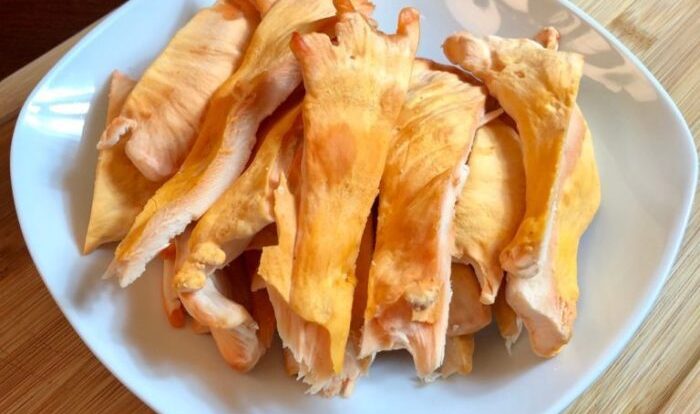
Embark on a culinary journey with our comprehensive guide to chicken of the woods recipe. From its unique flavor profile to its nutritional benefits, we’ll explore everything you need to know about this delectable wild mushroom.
Delve into the art of preparing and cooking chicken of the woods, discover its versatility in various cuisines, and uncover its potential health benefits. Let’s dive in and unlock the secrets of this culinary gem.
Cooking Techniques

Cooking chicken of the woods is a culinary adventure that offers a wide range of flavors and textures. Whether you prefer the earthy umami of sautéed mushrooms or the smoky char of grilled ones, there’s a cooking method to suit your taste buds.
Sautéing
Sautéing is a classic technique that allows the mushrooms to caramelize and develop a nutty flavor. Heat some butter or olive oil in a large skillet over medium heat. Add the mushrooms and cook, stirring occasionally, until they are golden brown and tender, about 10-15 minutes.
Grilling
Grilling imparts a smoky flavor to the mushrooms that complements their earthy taste. Preheat your grill to medium-high heat. Brush the mushrooms with olive oil and season with salt and pepper. Grill the mushrooms for 5-7 minutes per side, or until they are tender and slightly charred.
Roasting, Chicken of the woods recipe
Roasting is a great way to bring out the natural sweetness of chicken of the woods. Preheat your oven to 400°F (200°C). Toss the mushrooms with olive oil, salt, and pepper. Spread them on a baking sheet and roast for 20-25 minutes, or until they are tender and browned.
Flavor Profiles
Chicken of the woods, with its unique meaty texture and earthy flavor, offers a versatile culinary experience. It seamlessly adapts to various cuisines, complementing diverse palates and cooking techniques.
The mushroom’s inherent umami-rich flavor profile makes it a natural pairing for dishes that crave a savory boost. Its mild, earthy undertones allow it to harmonize with a wide range of seasonings, from classic herbs like thyme and rosemary to bolder spices like paprika and cumin.
Complementary Ingredients
To enhance the inherent flavors of chicken of the woods, consider incorporating ingredients that complement its earthy profile. Roasted root vegetables, such as carrots and parsnips, add a natural sweetness that balances the mushroom’s savory notes. A splash of white wine or lemon juice adds a touch of acidity, brightening the dish and bringing out the mushroom’s delicate flavors.
Versatile Seasonings
Seasoning chicken of the woods is a culinary adventure, as it readily absorbs and enhances the flavors it encounters. Garlic and onion, culinary staples, form a harmonious base for seasoning. Dried oregano and thyme add a touch of herbaceousness, while paprika brings a subtle smokiness.
For a more robust flavor, consider incorporating cumin, chili powder, or a touch of cayenne pepper.
Nutritional Benefits

Chicken of the woods is a nutritional powerhouse, boasting an impressive array of vitamins, minerals, and antioxidants that contribute to overall health and well-being.
It is particularly rich in:
Vitamin D
- Vitamin D is essential for bone health and immune function.
- Chicken of the woods is one of the few plant-based sources of vitamin D, making it a valuable addition to a vegan or vegetarian diet.
Antioxidants
- Chicken of the woods contains antioxidants such as ergothioneine, which protect cells from damage caused by free radicals.
- These antioxidants may help reduce the risk of chronic diseases such as cancer and heart disease.
Minerals
- Chicken of the woods is a good source of minerals such as potassium, phosphorus, and iron.
- Potassium is essential for maintaining blood pressure, while phosphorus and iron are crucial for bone health and oxygen transport, respectively.
Recipes and Variations: Chicken Of The Woods Recipe
Chicken of the woods is a versatile mushroom that can be used in a wide variety of dishes. Here are a few popular recipes to get you started:
Soups and Stews:Chicken of the woods adds a meaty flavor to soups and stews. Try adding it to your favorite beef or vegetable soup recipe, or make a creamy chicken of the woods soup with wild rice.
Stir-fries
Chicken of the woods is a great addition to stir-fries. It can be cooked with other vegetables, such as broccoli, carrots, and onions, or with meat, such as chicken or beef. Season with your favorite stir-fry sauce, and serve over rice or noodles.
Other Recipes
Chicken of the woods can also be used in a variety of other recipes, such as:
- Tacos:Shredded chicken of the woods can be used as a filling for tacos, topped with your favorite toppings.
- Pizza:Chicken of the woods can be used as a topping for pizza, along with other vegetables and cheese.
- Burgers:Chicken of the woods can be used as a patty for burgers, or as a topping for beef burgers.
Tips for Customizing Recipes:
Chicken of the woods is a versatile mushroom that can be used in a variety of recipes. Here are a few tips for customizing recipes to suit your own tastes and dietary restrictions:
- Add other vegetables:Chicken of the woods goes well with a variety of vegetables, such as broccoli, carrots, onions, and peppers. Add your favorite vegetables to your recipe to create a more flavorful dish.
- Use different seasonings:Chicken of the woods has a mild flavor, so it can be seasoned with a variety of herbs and spices. Experiment with different seasonings to find the flavor combination that you like best.
- Adjust the cooking time:Chicken of the woods can be cooked for a short or long period of time, depending on the desired texture. Cook it for a shorter period of time for a more tender texture, or cook it for a longer period of time for a more chewy texture.
Foraging and Identification
Identifying chicken of the woods in the wild requires careful observation. Its distinct appearance and habitat can guide you.
Chicken of the woods typically grows on dead or dying hardwood trees, particularly oaks and maples. It is commonly found in deciduous forests during the fall, from late summer to early winter.
Look-alikes
Despite its distinctive features, there are a few look-alikes to be aware of:
- False Chicken of the Woods (Laetiporus sulphureus) : This species has a similar appearance, but its flesh is thin and often bitter or inedible.
- Jack-o’-Lantern Mushroom (Omphalotus illudens) : This toxic mushroom glows in the dark and has gills instead of pores.
Wrap-Up

As we conclude our exploration of chicken of the woods recipe, we’ve unveiled its culinary prowess and nutritional value. Whether you’re a seasoned chef or a curious home cook, this guide has equipped you with the knowledge to create mouthwatering dishes that celebrate the wonders of nature.
So, venture forth, forage for this wild delicacy, and let the flavors of chicken of the woods ignite your culinary passion.
Helpful Answers
What are the look-alikes of chicken of the woods?
Chicken of the woods has a few look-alikes, including false chicken of the woods and sulfur shelf. It’s crucial to be able to identify these look-alikes to avoid consuming toxic mushrooms.
Can chicken of the woods be eaten raw?
No, chicken of the woods should not be eaten raw. Cooking helps to break down the mushroom’s tough texture and release its full flavor.
What are the health benefits of chicken of the woods?
Chicken of the woods is a good source of vitamins, minerals, and antioxidants. It has been shown to have anti-inflammatory and anti-cancer properties.





